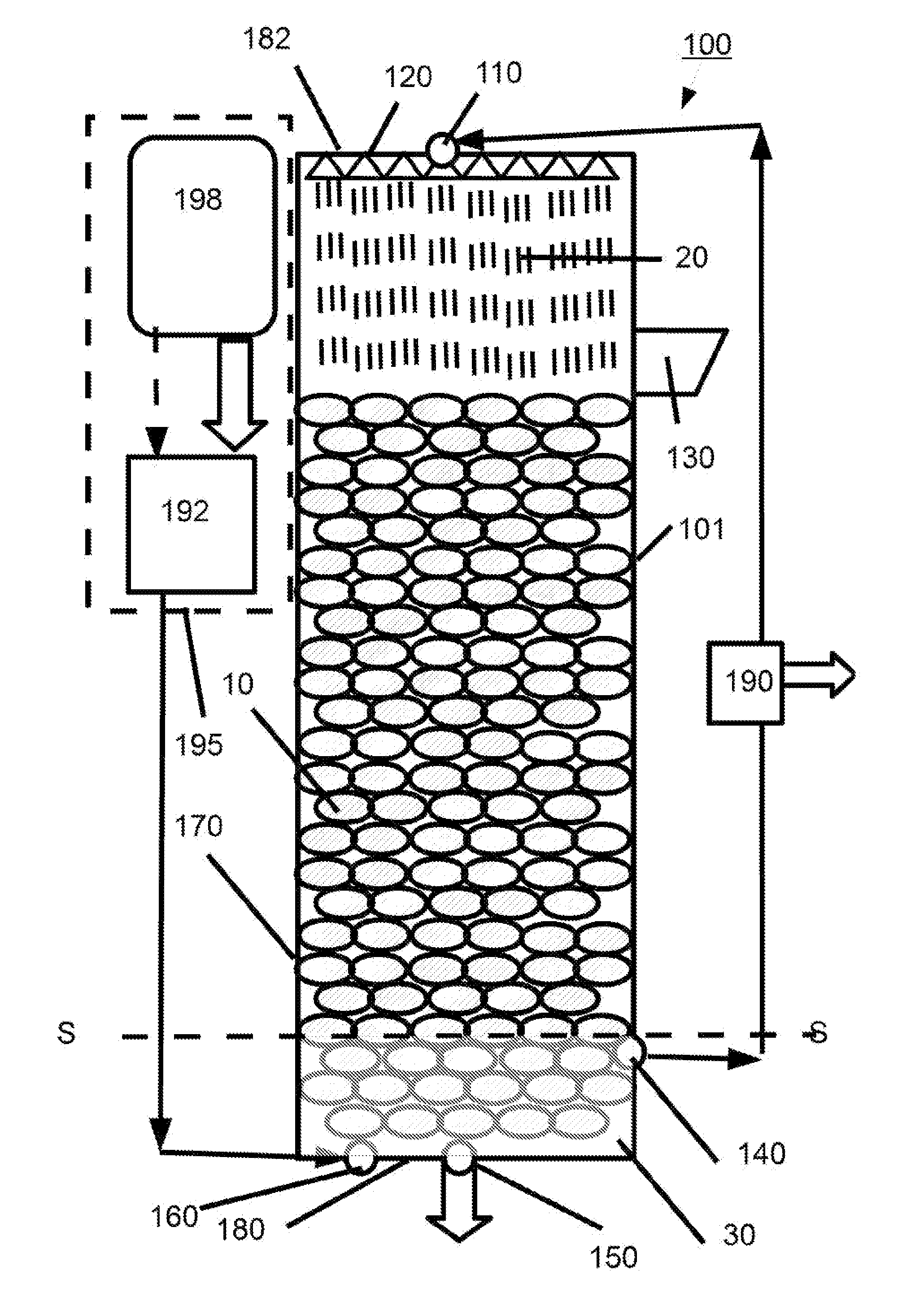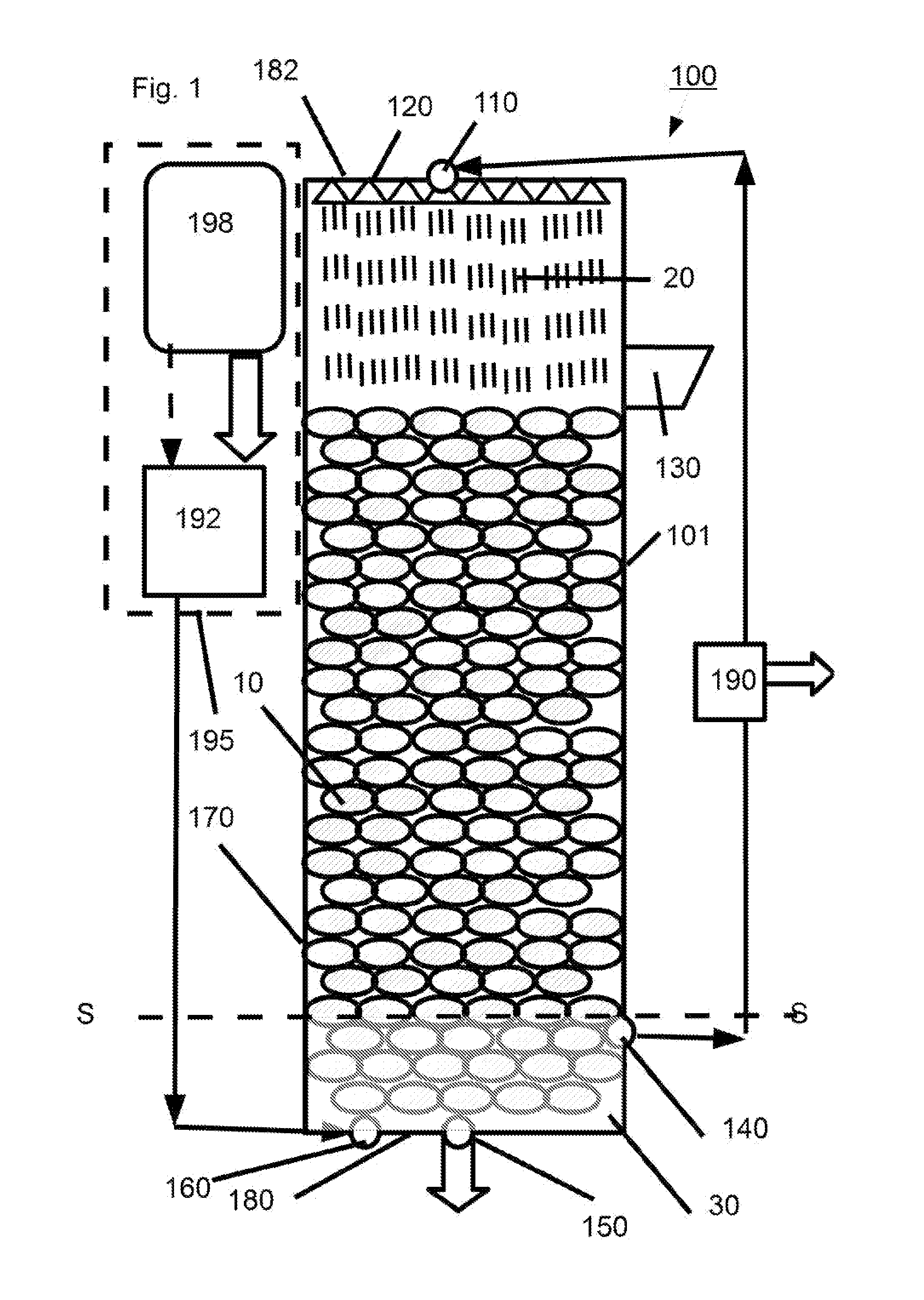Hydrolysis systems and methods
a technology of hydrolysis and systems, applied in the field of hydrolysis systems and methods, can solve the problems of increasing consumption by industry and affecting food costs, and the technical problems of soluble carbohydrates production, and the proposed technologies have presented technical problems which remain to be overcome, so as to reduce the residence time of solids, reduce the residence time of acid, and increase the yield of sugar
- Summary
- Abstract
- Description
- Claims
- Application Information
AI Technical Summary
Benefits of technology
Problems solved by technology
Method used
Image
Examples
example 1
Pilot Scale Simulated Moving Bed System
[0684]In order to confirm the viability of systems of the type depicted in FIGS. 6a to 6d and 4 using trickling bed reactors of the type depicted in FIG. 7, a pilot system was constructed and tested.
[0685]The pilot system included 7 reactors 7300 and an upstream “hydration vessel”. Each reactor was a vertical cylinder with height (h) of 228.6 cm and diameter (d) of 45.72 cm. This configuration gives an approximate internal volume of 375.3 liters and a horizontal cross-sectional area of approximately 1641.7 cm2. The aspect ratio h:d of the reactor is 5.0.
[0686]Hydration was conducted by loading the hydration vessel with 31.8 kilos of pine wood chips and submerging it in acidic effluent from the most downstream reactor.
[0687]During hydrolysis 540 (FIG. 9), L is circulated in each reactor at a rate of 17.8 liters / minute.
[0688]L provided in the most upstream reactor was cooled to a temperature of 12° C. During system operation, a temperature gradie...
example 2
Theoretical Scale Up Calculation For Simulated Moving Bed System
[0693]In order to expand the capacity of the system described in Example 1 from 7.95 kilos of woody substrate per / hour to 60000 kilos of substrate per hour, a scale up of 7547.2 times is needed. This means that the desired reactor volume is 2832453 liters.
[0694]Assuming that the h:d aspect ratio of 5 is to be retained, a reactor with a diameter of about 896.8 cm and a height of about 4484 cm should be constructed. This reactor will have a cross sectional area of 631656 cm2. It is believed that a recirculation rate increased in proportion to this area is desired in order to preserve the trickling bed effect described in Example 1. Calculation suggests that a recirculation rate of 6848 liters / minute is appropriate for the proposed scaled up reactor.
[0695]It is believed that this structure will preserve the desirable effects of the trickling bed design during scale-up.
example 3
Kinetics of Hydrolysis of Wood with 35% HCl at 35° C.
[0696]In order to simulate reaction conditions in the trickling bed portion of an exemplary reactor (i.e. above line S-S in FIG. 1) hammer milled yellow pine was steam exploded and extracted with acetone then hydrolyzed with 35% HCl for different periods of time (2, 4, 6, 8, and 10 h) at 35° C. while stirring. These conditions are similar to some exemplary embodiments of the trickling bed portion of the reactor in terms of temperature and acid concentration.
[0697]However, in this simulation, the ratio of acid to wood was 10:1. The stirring in a large excess of acid simulates to some extent removal of acid via port 140 in FIG. 1.
[0698]The content of dissolved sugars in the liquid was determined at different time points and the percentage of sugars remaining on the wood as insoluble carbohydrates (e.g. cellulose and / or hemicellulose) was calculated by difference.
[0699]Results are summarized graphically in FIG. 14. After 2 hours in 3...
PUM
| Property | Measurement | Unit |
|---|---|---|
| Temperature | aaaaa | aaaaa |
| Fraction | aaaaa | aaaaa |
| Fraction | aaaaa | aaaaa |
Abstract
Description
Claims
Application Information
 Login to View More
Login to View More - R&D
- Intellectual Property
- Life Sciences
- Materials
- Tech Scout
- Unparalleled Data Quality
- Higher Quality Content
- 60% Fewer Hallucinations
Browse by: Latest US Patents, China's latest patents, Technical Efficacy Thesaurus, Application Domain, Technology Topic, Popular Technical Reports.
© 2025 PatSnap. All rights reserved.Legal|Privacy policy|Modern Slavery Act Transparency Statement|Sitemap|About US| Contact US: help@patsnap.com



